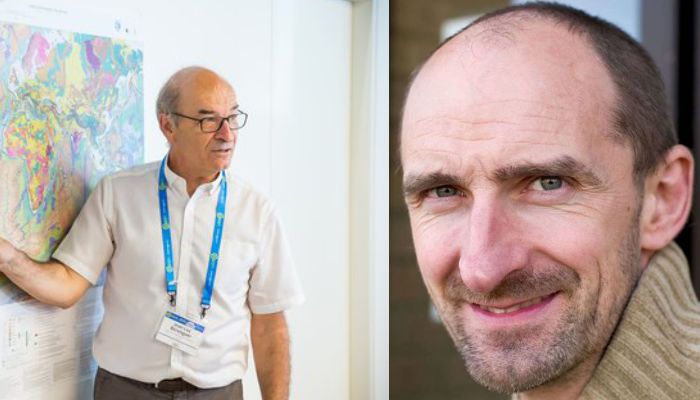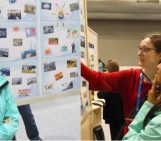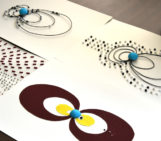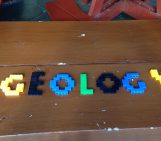
EGU’s annual Geoscience Information For Teachers (GIFT) workshop will take place between 4 – 8 April 2022, with the theme of “How the planet shapes history – Geosciences, human society and civilizations”. To find out more about what GIFT is and get a taster for the workshop’s content EGU’s Programme Coordinator, Simon Clark, talked with two of the organisers: the Education Committee’s Deputy Chair, Jean-Luc Berenguer, and Secretary, Phil Smith.
Hello! Thank you for agreeing to his interview! Could you both please introduce yourselves and your roles within the Education Committee?
Jean-Luc: I am Jean-Luc Berenguer. In addition to teaching in secondary schools, I lead actions that link research and education. This is the case, for example, with the Education component of the InSight mission, or the Mediterranean Environment Observatory for Educational Purposes (EDUMED). I do all this as part of the Education team of the Geoazur research laboratory based on the French Riviera. Within the EGU, I participate in the implementation of all the actions of the Education Committee as Deputy Chair. I make sure that all the planned actions run on time and with the best impact towards our target audience.
Phil Smith: Hello Simon. My name is Dr. Phil Smith, I am a long-standing member of the Committee for Education and recently became its secretary. For my day job I run a science education charity in the UK that supports science education (called the Teacher Scientist Network). One thing we promote to our teachers is subject knowledge focussed CPD (Continued Professional Development), so GIFT has been a natural marriage between my networks and our aspirations for GIFT. By background I am a plant pathologist (but an honorary geoscientist for the sake of GIFT!)
Can you briefly introduce Geoscience Information For Teachers (GIFT) for our readers who may be unfamiliar with the programme?
Jean-Luc: GIFT is a scientific seminar for secondary school teachers, organised within the framework of the EGU General Assembly, and therefore in contact with the research community. We take advantage of their presence to offer teachers conferences of a high scientific level, where the concepts are well taught by the lecturers. GIFT is also an event for exchanges and networking between teachers from several countries; the teaching of geosciences varies greatly in Europe, and the experience of each is very useful.
Phil Smith: In a nutshell, GIFT is a tremendous opportunity for secondary school teachers around the world to boost their subject knowledge in the geosciences. It’s a mix of lectures from experts in their field (all linked to the theme of the workshop, which changes annually) and hands-on experiences, even when we are virtual! It’s a GIFT from EGU to the world of education! (Sorry couldn’t resist that one!)
GIFT has been running for nearly 20 years now, which seems like an clear indicator of success! From your experience, what do teachers and scientists gain from GIFT events?
Jean-Luc: Already in 2003, I was involved in the Education Committee of the EGU. It was the early days! We had to test whether a seminar for teachers within the General Assembly could have a future. There was no talk of GIFT yet! Today, the testimonies we receive after each GIFT are unanimous: GIFT is a highlight in the professional life of teachers. They tell us that they have found new energy, that they have had the opportunity to refresh their knowledge, and that they have made new professional contacts. Every year, we receive feedback from these teachers who tell us how they have developed new projects based on their experiences at GIFT. I think that the experience of the first years was successful and that GIFT was a really good idea!
Phil Smith: GIFT is a very enriching experience for both teachers and scientists. The teachers benefit in the ways Jean-Luc has described, but for me the highlight is when a speaker or the overall experience re-ignites a teacher’s passion for the subject – bringing them up-to-date in specific subject knowledge reminds them why they teach, why they went into teaching, and provides them with new nuggets of information to share with their pupils when they are back in class. There is so much administration and curriculum ‘to get through’ that such are experiences are invaluable to the teachers.
For the scientists, they have the challenge of presenting their work in an accessible way, and sometimes the questions from the audience can make them think about their research in new ways. This too can be refreshing for the scientist.
This year’s virtual GIFT (vGIFT) is just around the corner. Could you say what people can expect from this year’s vGIFT, both in terms of content and how they can engage with it?
Jean-Luc: Since 2020, GIFT has been an online seminar. The popularity of the lectures is still high. This year again, leading specialists will present geosciences from an original angle, but one that is so necessary today: “How the planet shapes history.” Our societies have always evolved to the rhythm of volcanic eruptions, earthquakes, glaciers, climatic fluctuations. This year, there will be a lot of knowledge to update on this topic. Of course, the sharing moment between teachers during practical activities or the poster session will not take place once again. We will try to make up for this by maintaining a more continuous link with all these teachers through other actions.
Phil Smith: More of the same – more inspiration, more ideas, and giving teachers a broader insight than they may first have imagined into the effects of a number of natural hazards. Unfortunately we are online again this year – we are really hopefully we can return to the face-2-face format in 2023 in Vienna – but by being virtual many more teachers are able to be involved!
Finally, how can people get involved with the GIFT programme or any other Education Committee activities?
Jean-Luc: Indeed, the Committee’s actions are not limited to GIFT. There are other seminars for which the Committee helps teachers participate. These are field courses that take place in emblematic geoscience locations. Teachers can apply to participate in these workshops. It is also possible to become, as a teacher, a geoscience trainer in your country. The committee has been working for a few years on setting up a network of field officers. In this way, numerous geoscience training activities are possible under the aegis of the EGU. Finally, the Committee is working to improve teaching at the University-level by producing resources available online.
The Committee is now celebrating its 20th anniversary this year; new challenges are still to be taken up so that geosciences education is helped, improved, and amplified throughout Europe.
Phil Smith: Do check out our website, the content from previous GIFTs are catalogued there and there are many PowerPoints and recordings of presentations that would be ideal for teaching undergraduates. Indeed, this is one area we are trying to develop going forward so that the GIFT resources can be more easily searched and accessed by those in Higher Education. We hope the scientific divisions of EGU will continue to support us, opening doors that lead to speakers when we build GIFT programmes in the future.




